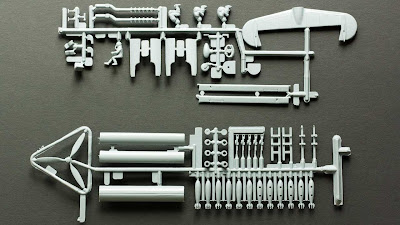In theory, once the aluminium finish was applied, painting stage of this project should have been practically finished. All that remained was the anti-glare olive drab stripe on the top of the fuselage and red edging at the front of engine cover. I decided to apply the olive stripe first. Masking the correct shape turned out to be much trickier that I expected, but after some trial and error I managed to tape off a shape that looked satisfactory. Next time, I will make my life a bit easier and will first make a paper template which I will the be able to use forboth sides of the stripe, instead of eyeballing it. Extra effort maybe, but at least the shape will be guaranteed uniform on both sides.
Couple of words regarding the paint I used for the anti-glare stripe, the Olive Drab "acrylic" from Tamiya. Yet another paint from that producer that behaved wonderfully when airbrushed - absolutely smooth finish with a bit of thinning and a delight in regard of control. I must say that Tamiya paints are quickly becoming my favorites when it comes to airbrushing, with LifeColor and Vallejo Air in second place and Humbrol as a distant third choice. It's such a shame that Tamiya's color range is so limited.
Final detail that I wanted to paint with the airbrush was the red 'edging' on the engine cover. Foolishly I decided to mask only the part of the component - after all all it would take would be a quick pass with the airbrush. Wrong! The Humbrol acrylic paint I used for the job (Crimsom Gloss 29) turned out to have very poor coverage and several layers were required to cover the olive drab stripe at the top. Due to lacking control of the airbrush and mounting frustration, I managed to overspray the masking in several places. This meant that I now had to mask of the red edging before correcting my mistakes. Said and done... the only problem was that when I removed the masking tape covering the red paint, the section that was sprayed over the Tamiya Olive Drab followed along with the tape like some sort of latex skin. I don't think I need to describe my frustration at that time.
Luckily, I was able to remove all of the Humbrol paint from the engine cover with my fingernails before more or less starting from scratch. This time around I applied red paint directly on the Alclad metalic and then resprayed the olive drab stripe.
After letting the paint dry for a couple of hours, I've decided to do 'just a little' work on the decals. The most prominent decal for this particular model is a head of an Indian chief, covering the left side of engine cover and fuselage. To fit, the decal had to be cut in two pieces before applying. I marked the outline of the engine cover on the backside of the decal, cut it in two and put the parts in appropriate positions. I was a bit surprised over how easy it went... I was also quite disappointed in the quality of the decal - its white sections are translucent', clearly showing the deep red of underlying surface. The problem is consistent for all decals for this kit, white sections show through quite a bit. It's a shame, because otherwise it's an excelent set of decals, with vivid colors and resilient to handling. Also, Microset and Microsol seem to work with them rather well.
Oh well... once the indian head was in place I decided to apply 'just a couple more decals'. Three and half hour later, even the most miniscule decals were in place.

















































